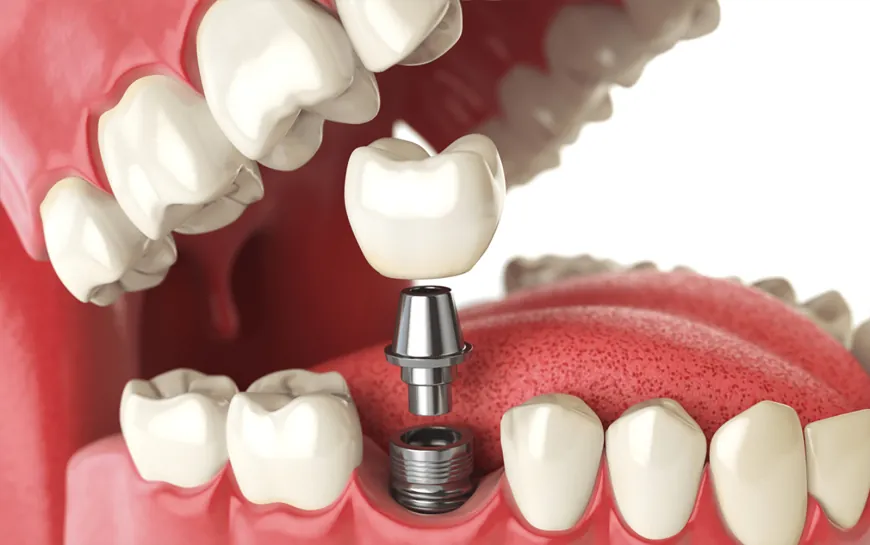The Future of Dental Restoration: Exploring Dental Implants
Do you have a missing tooth? Do you want to get it replaced with an implant? We've got you covered. Read to learn more about Dental Implants in Dubai, Abu Dhabi.

Dental restoration has evolved significantly over the years, with technological advancements reshaping how dental professionals restore lost or damaged teeth. Among these innovations, dental implants have emerged as a game-changer in the field of dentistry. In this article, we will explore the future of dental restoration by examining the role and development of dental implants, their benefits, and what to expect in the years to come.
Understanding Dental Implants:
A dental implant is a titanium post that is surgically placed into the jawbone to replace the root of a missing tooth. Once integrated with the bone, the implant acts as a sturdy foundation for attaching a crown, bridge, or denture. Dental Implants in Dubai have become a preferred choice for tooth restoration due to their durability, functionality, and natural appearance.
The procedure for dental implants has undergone refinement over the years. With the advent of computer-aided design (CAD) and computer-aided manufacturing (CAM), implant placement is more precise and customized to meet each patient’s unique needs.
Benefits of Dental Implants:
Enhanced Functionality:
Dental implants restore full function to the mouth. Unlike dentures, which may shift or slip, implants allow patients to chew, speak, and smile with confidence. The implant mimics the natural tooth root, offering stability and strength that can’t be matched by traditional dentures or bridges.
Improved Aesthetics:
Implants are designed to look and feel like natural teeth. With advances in materials such as zirconia and porcelain, dental implants can blend seamlessly with existing teeth, making them virtually indistinguishable from natural teeth.
Preservation of Jawbone Health:
When a tooth is lost, the underlying jawbone can begin to deteriorate due to lack of stimulation. Dental implants prevent this bone loss by stimulating the jawbone as natural tooth roots do. This helps maintain the structure and integrity of the jaw, preventing further issues such as facial sagging.
Long-Term Durability:
Dental implants are designed to last a lifetime. While crowns and bridges may need to be replaced over time, implants typically have a success rate of over 95% and, with proper care, can remain functional for decades. This longevity makes them a cost-effective solution in the long run.
The Evolution of Dental Implant Technology:
3D Imaging and Guided Surgery:
The use of 3D imaging and computer-guided surgery has significantly improved the accuracy of dental implant placement. 3D scans provide a detailed view of the jawbone, allowing dentists to plan the implant procedure with precision. Guided surgery helps to ensure the implant is placed in the optimal position, reducing the risk of complications.
Immediate Implant Placement:
In the past, patients who underwent dental implant procedures had to wait several months for the implant to fuse with the bone before placing the final restoration. However, with advancements in techniques and materials, it is now possible to place implants immediately after a tooth extraction in some cases. This means less downtime for the patient and faster results.
Biocompatible Materials:
The use of biocompatible materials such as titanium and ceramic is a significant factor in the success of dental implants. Titanium is highly compatible with the jawbone, making it an ideal material for long-term use. Additionally, researchers are exploring alternative materials, including zirconia, which offer increased strength and aesthetics for patients with specific needs or allergies.
Mini Implants:
Mini dental implants are a recent development that offers a less invasive option for those with limited jawbone density. These smaller implants are placed without the need for bone grafting and are ideal for patients who may not be suitable candidates for traditional implants. They provide a quicker, more affordable solution for restoring missing teeth.
Future Trends in Dental Implant Technology:
Smart Implants and Artificial Intelligence:
The future of dental implants will likely see the integration of smart technologies and artificial intelligence (AI). Smart implants could have built-in sensors to monitor the health of the implant and the surrounding tissue. These sensors would provide real-time data to both the patient and the dentist, helping detect potential issues early on and preventing complications.
AI could also assist in the planning and design of dental implants. Advanced algorithms could analyze 3D scans to recommend the best possible implant placement and design based on the patient’s unique anatomy, improving precision and outcomes.
Advanced Bone Regeneration Techniques:
Bone loss is a common challenge in implant procedures, especially for patients who have been missing teeth for a long time. New advancements in bone regeneration techniques, such as tissue engineering and stem cell therapy, offer hope for improving the success of dental implants in patients with insufficient bone density. These techniques aim to stimulate natural bone growth, making dental implants more accessible to a broader range of patients.
3D-Printed Implants:
3D printing is already being used to create dental crowns and bridges, but in the future, we may see 3D-printed dental implants becoming more common. 3D-printed implants could be customized to an individual’s mouth with unparalleled precision. These implants would be created based on digital impressions and could provide a more cost-effective and efficient option for tooth restoration.
Faster Recovery and Minimally Invasive Procedures:
The dental implant process is likely to become even less invasive in the future. New techniques, such as laser-assisted surgery and minimally invasive procedures, aim to reduce recovery times and minimize discomfort for patients. With less trauma to the surrounding tissue, patients can expect quicker healing and less post-surgical pain.
Cost and Accessibility of Dental Implants:
While dental implants offer numerous advantages, one of the primary challenges remains the cost. In many parts of the world, dental implants are considered a premium service, making them inaccessible to some patients. However, as technology advances and more efficient methods of production and placement are developed, it is likely that the cost of implants will decrease, making them a more affordable option for a wider range of patients.
Additionally, the rise of dental tourism, particularly in countries like Dubai, where dental implants are offered at competitive prices, is making high-quality implant procedures more accessible to international patients.
Conclusion:
Dental implants represent the future of dental restoration, providing patients with a long-lasting, functional, and aesthetically pleasing solution for missing teeth. With continued advancements in technology, the future of dental implants is incredibly promising. From smart implants and 3D printing to innovative bone regeneration techniques, the next generation of dental restoration promises to offer even more precise, accessible, and affordable solutions for patients worldwide. As dental professionals continue to embrace these developments, patients can look forward to more personalized, efficient, and pain-free implant procedures.
What's Your Reaction?
 Like
0
Like
0
 Dislike
0
Dislike
0
 Love
0
Love
0
 Funny
0
Funny
0
 Angry
0
Angry
0
 Sad
0
Sad
0
 Wow
0
Wow
0




















































